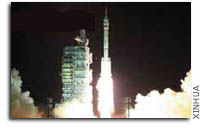China’s Shenzhou II Returns to Earth

China’s Shenzhou II spacecraft returned to Earth at 6:22 AM EST [11.22 GMT] on Tuesday after making 108 orbits of Earth. The Shenzhou’s Reentry Module parachuted to a landing site in China’s inner Mongolia while Shenzhou’s Orbital Module continued to operate in orbit. It is expected that the Orbital Module (powered by its own photovoltaic arrays) will continue to operate for some time, perhaps several months.
Shenzhou II was launched on 9 January 2001 from China’s Jiuquan Satellite Launch Center aboard a Long March 2F (CZ-2F) launch vehicle. Shenzhou I made a much shorter trip into space in November 1999. Both Shenzhou spacecraft were placed in circular orbits with a 42.6 degree inclination.
Shenzhou II – like its predecessor, Shenzhou I, is a testing prototype for a human spacecraft. While China is reluctant to describe its plans for humans in space, it is widely expected that this second (apparently) successful test flight will pave the way for Chinese astronauts in space within the next year or so.
The Shenzhou design is based upon the Russian Soyuz spacecraft with some substantial modifications. The Reentry Module is larger in diameter than Soyuz fueling suspicions that it may be able to accommodate 3 (or more) astronauts and logistics in a less cramped fashion than Russia’s Soyuz. Shenzhou is also rumored to have better batteries, more propulsion capability, and more modern avionics than Soyuz.
The Orbital Module attached to the forward end of Shenzhou’s reentry module is also much more sophisticated than that used on Soyuz. Equipped with its own solar arrays, this module is capable of extended autonomous performance. The Orbital Module, like that on Soyuz, is also designed to accommodate a docking adaptor similar to that used by Russia – and now adopted for use on the Russian portion of the International Space Station. Some China space watchers have speculated that this module is designed to remain attached to a space station China has spoken vaguely of building towards the end of this decade.
Shenzhou II is reported to have made several propulsion system tests while in orbit. In addition to testing the spacecraft’s various systems, scientific research was carried out aboard Shenzhou II. Although only vaguely described by Chinese officials small research animals and microorganisms were used in a variety of experiments.
Related Links
Comments by Luo Ge, Director General,
Department of Foreign Affairs China National Space
Administration to the International Space Business
Assembly (ISBA) held in Washington, D.C. in November 1999.








